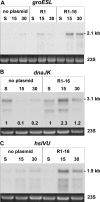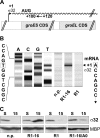Expression and assembly of a functional type IV secretion system elicit extracytoplasmic and cytoplasmic stress responses in Escherichia coli
- PMID: 16952953
- PMCID: PMC1595493
- DOI: 10.1128/JB.00632-06
Expression and assembly of a functional type IV secretion system elicit extracytoplasmic and cytoplasmic stress responses in Escherichia coli
Abstract
Conditions perturbing protein homeostasis are known to induce cellular stress responses in prokaryotes and eukaryotes. Here we show for the first time that expression and assembly of a functional type IV secretion (T4S) machinery elicit extracytoplasmic and cytoplasmic stress responses in Escherichia coli. After induction of T4S genes by a nutritional upshift and assembly of functional DNA transporters encoded by plasmid R1-16, host cells activated the CpxAR envelope stress signaling system, as revealed by induction or repression of downstream targets of the CpxR response regulator. Furthermore, we observed elevated transcript levels of cytoplasmic stress genes, such as groESL, with a concomitant increase of sigma(32) protein levels in cells expressing T4S genes. A traA null mutant of plasmid R1-16, which lacks the functional gene encoding the major pilus protein pilin, showed distinctly reduced stress responses. These results corroborated our conclusion that the activation of bacterial stress networks was dependent on the presence of functional T4S machinery. Additionally, we detected increased transcription from the rpoHp(1) promoter in the presence of an active T4S system. Stimulation of rpoHp(1) was dependent on the presence of CpxR, suggesting a hitherto undocumented link between CpxAR and sigma(32)-regulated stress networks.
Figures







Similar articles
-
The Cpx envelope stress response affects expression of the type IV bundle-forming pili of enteropathogenic Escherichia coli.J Bacteriol. 2005 Jan;187(2):672-86. doi: 10.1128/JB.187.2.672-686.2005. J Bacteriol. 2005. PMID: 15629938 Free PMC article.
-
[Genetic regulation of the heat-shock response in Escherichia coli].Rev Latinoam Microbiol. 2001 Jan-Mar;43(1):51-63. Rev Latinoam Microbiol. 2001. PMID: 17061571 Spanish.
-
Controlled induction of the RpoS regulon in Escherichia coli, using an RpoS-expressing plasmid.Can J Microbiol. 2003 Dec;49(12):733-40. doi: 10.1139/w03-096. Can J Microbiol. 2003. PMID: 15162198
-
Periplasmic stress and ECF sigma factors.Annu Rev Microbiol. 2001;55:591-624. doi: 10.1146/annurev.micro.55.1.591. Annu Rev Microbiol. 2001. PMID: 11544368 Review.
-
Sensing external stress: watchdogs of the Escherichia coli cell envelope.Curr Opin Microbiol. 2005 Apr;8(2):122-6. doi: 10.1016/j.mib.2005.02.013. Curr Opin Microbiol. 2005. PMID: 15802241 Review.
Cited by
-
Small heat-shock protein HspL is induced by VirB protein(s) and promotes VirB/D4-mediated DNA transfer in Agrobacterium tumefaciens.Microbiology (Reading). 2009 Oct;155(Pt 10):3270-3280. doi: 10.1099/mic.0.030676-0. Epub 2009 Jun 25. Microbiology (Reading). 2009. PMID: 19556291 Free PMC article.
-
The role of the two-component systems Cpx and Arc in protein alterations upon gentamicin treatment in Escherichia coli.BMC Microbiol. 2017 Sep 18;17(1):197. doi: 10.1186/s12866-017-1100-9. BMC Microbiol. 2017. PMID: 28923010 Free PMC article.
-
Cell density-dependent antibiotic tolerance to inhibition of the elongation machinery requires fully functional PBP1B.Commun Biol. 2022 Feb 3;5(1):107. doi: 10.1038/s42003-022-03056-x. Commun Biol. 2022. PMID: 35115684 Free PMC article.
-
Promoters of Escherichia coli versus promoter islands: function and structure comparison.PLoS One. 2013 May 22;8(5):e62601. doi: 10.1371/journal.pone.0062601. Print 2013. PLoS One. 2013. PMID: 23717391 Free PMC article.
-
Conjugal transfer of the Salmonella enterica virulence plasmid in the mouse intestine.J Bacteriol. 2008 Mar;190(6):1922-7. doi: 10.1128/JB.01626-07. Epub 2008 Jan 4. J Bacteriol. 2008. PMID: 18178735 Free PMC article.
References
-
- Bardwell, J. C., K. McGovern, and J. Beckwith. 1991. Identification of a protein required for disulfide bond formation in vivo. Cell 67:581-589. - PubMed
-
- Baron, C., D. O'Callaghan, and E. Lanka. 2002. Bacterial secrets of secretion: EuroConference on the biology of type IV secretion processes. Mol. Microbiol. 43:1359-1365. - PubMed
-
- Barrios, A. F., R. Zuo, D. Ren, and T. K. Wood. 2006. Hha, YbaJ, and OmpA regulate Escherichia coli K12 biofilm formation and conjugation plasmids abolish motility. Biotechnol. Bioeng. 93:188-200. - PubMed
Publication types
MeSH terms
Substances
LinkOut - more resources
Full Text Sources
Molecular Biology Databases

